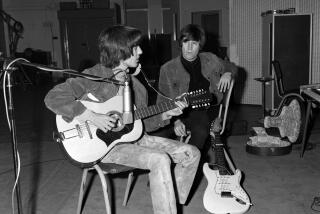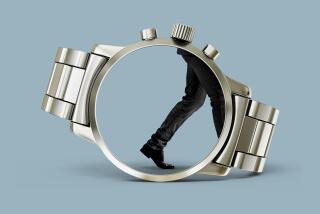Wealthy car collectors, auction firms to gather in Arizona
If $8 million sounds like too much for a 1960 Ferrari, perhaps a 1958 model in the range of $5.5 million to $7 million better suits your budget.
Such are the choices the world’s wealthiest car collectors will face this month in Arizona. Every year, buyers, sellers and car nuts descend on Scottsdale and Phoenix for one of the largest gatherings of car auctions in the country.
“This is it. This is the big one,” McKeel Hagerty says of the week of auctions. Hagerty is founder and chief executive of Hagerty Insurance Agency, which insures and tracks sale prices of classic cars. “It is a bucket list item for any car guy at some point in your life.”
Photos: Highlights of the classic cars offered in Arizona
Thousands of vehicles will be auctioned by companies including Gooding & Co. of Santa Monica, RM Auctions, Bonhams, Barrett-Jackson and Russo & Steele. The models offered range from a 1926 Cadillac to a 2012 Shelby GT500 Super Snake, with prices from the low $20,000s to the high seven figures. Auctions run Jan. 15-20.
Barrett-Jackson says around 270,000 people attended its 2012 Arizona event over the course of a week, and the company expects to top that number this year.
Antique car buffs now consider the Arizona event on par with the Monterey car week held every August in California. Although the Monterey week offers an amalgam of events including heritage racing, car auctions and the Pebble Beach Concours d’Elegance, Arizona is strictly auctions.
“Everybody there is very much in the mood to buy and sell,” David Gooding, president and chief executive of Gooding & Co., said of Scottsdale. “At Pebble, there’s just so much going on that people sometimes are a little less focused. Everybody tends to get a little stressed out and tired.”
The pair of rare Ferraris, offered by rival auction houses, probably will compete for bragging rights that go with the top-dollar sale.
Gooding & Co., which has a five-year streak of selling the priciest car, is bringing a 1958 Ferrari 250 GT LWB California Spider. The long-wheelbase convertible is one of only 50 built and features a 3.0-liter V-12 that makes at least 250 horsepower. The car has been certified by Ferrari as a matching-numbers example and has been shown at elite car shows including Pebble Beach. Matching-numbers cars are those that still have original components such as the engine with identification numbers that match those on other parts of the vehicle.
“There’s nothing you can fault on this car; it’s as nice as it can be,” David Gooding said of the midnight blue California Spider.
His company estimates that the car will bring $5.5 million to $7 million if it sells.
Challenging the Spider for the top sale will be another rare Ferrari sold by RM Auctions, a 1960 250 GT SWB Berlinetta “Competizione.” Only 74 of the roughly 170 short-wheelbase 250 GT cars were made in this lighter, street-legal racing version with a V-12 engine that makes close to 300 horsepower.
Since many were raced — and crashed — few match this copy’s provenance. It’s had just four owners, and its crash-free and original-engine status make it a rare “no stories” car. These models are also balanced and welcoming cars to drive, a trait not shared by all race-spec Ferraris of the era.
“It’s one of the holy grails for Ferrari collecting, because they look nice, they perform well, and yet they’re kind of tame,” Hagerty said. He estimates the car could sell for $6 million to $10 million.
Old Ferraris in general have been fetching ever-increasing prices, according to Hagerty Insurance, which tracks the average price of Ferraris sold and reports a 59% increase in the last 36 months. In part, the surge is driven by the fact that ownership grants the buyer entry to the world’s most exclusive driving events, including road rallies and other Concours car shows.
“There are events around the world that you don’t get invited to unless you have one of these,” Hagerty says. “You don’t get to be the guest of somebody who goes. You either own it or you’re not going.”
The week of auctions traces its roots back to 1971, when Tom Barrett and Russ Jackson hosted their first auction of around 80 cars in Scottsdale. The pair soon after formed Barrett-Jackson, a classic-car auction company that today is among the world’s largest. By 1997, the Speed Channel was covering the weeklong Barrett-Jackson auction live.
By 2001, after years of increased foot traffic to the weeklong event, other auction companies had started hosting similar sales nearby with the hopes of attracting buyers interested in a wider range of vehicles than the American muscle cars Barrett-Jackson was known for selling.
“It’s the great example of if you put one gas station on a corner, then slowly all four corners have a gas station — and they all seem to do well,” Hagerty said of the growth.
The event’s rising popularity, due in no small part to television coverage, has benefited every car fan, said Jackson’s son Craig, the chairman and CEO of Barrett-Jackson. “I think it’s had a role in expanding the car hobby in general,” he said. “It’s brought thousands of new people in.”
Although Italian exotics steal the limelight, a majority of the week’s sales are cars with more reasonable prices, from $20,000 to $100,000. More common offerings will include American classics such as 1957 Chevys, Corvettes and Ford Mustangs.
Even if you don’t intend to buy, the auctions can still be fun to watch.
“There are a lot of cars that are kind of affordable. It’s fun to go to those things, because you’re sort of afraid you’re going to start waving your hand around at the least convenient moment,” Hagerty said. “And of course that’s exactly what the auction companies want you to do.”
More to Read
Inside the business of entertainment
The Wide Shot brings you news, analysis and insights on everything from streaming wars to production — and what it all means for the future.
You may occasionally receive promotional content from the Los Angeles Times.











